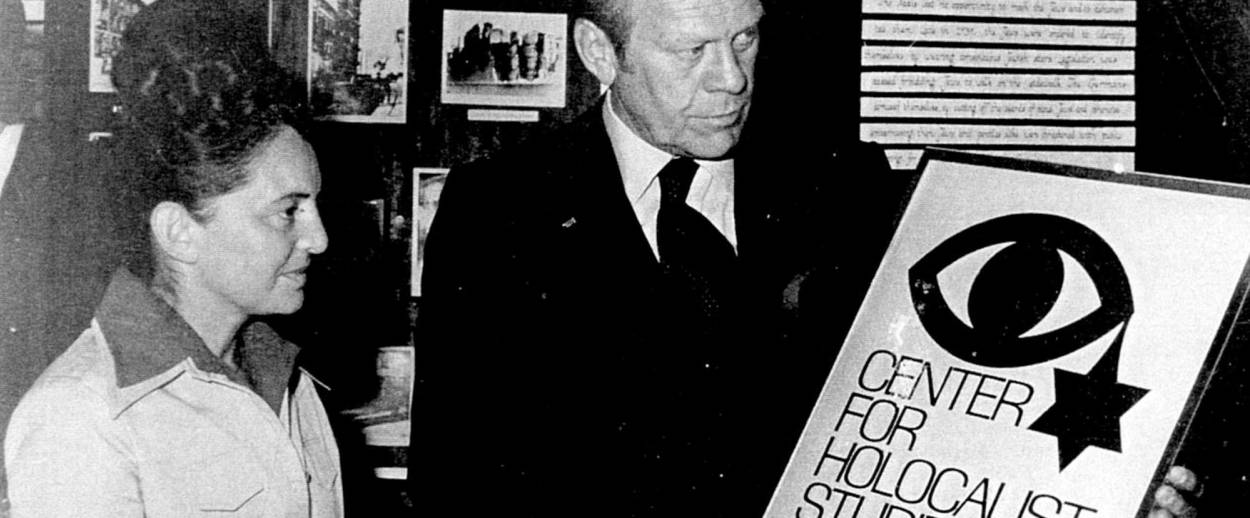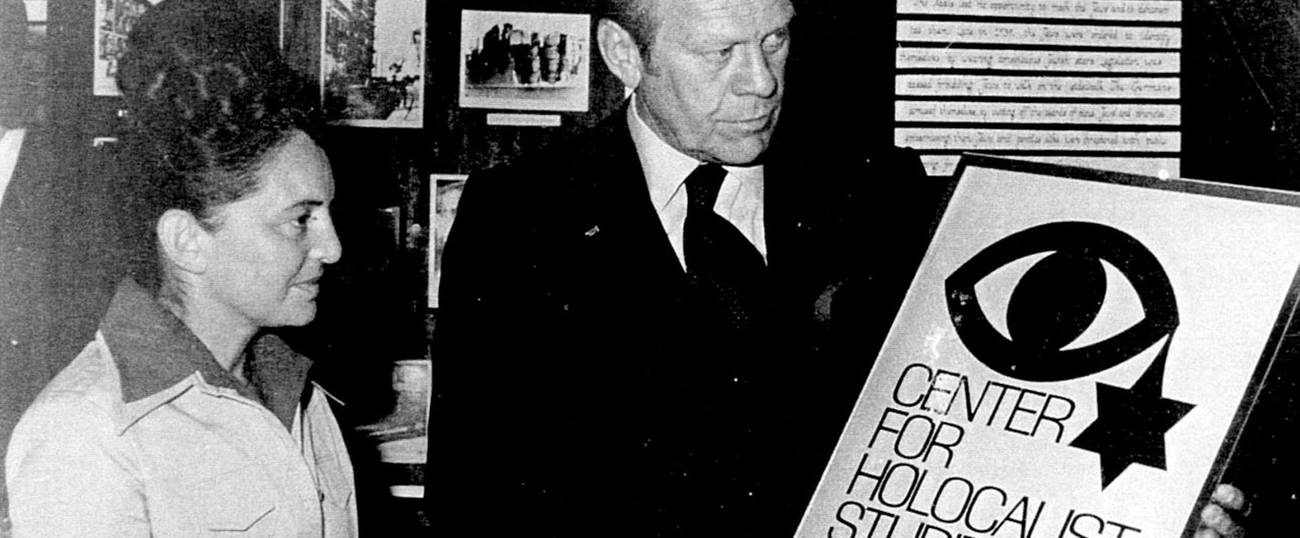Yaffa Eliach, the Voice of Hasidic Tales of the Holocaust
The pioneering scholar, who died last week at 79, showed American Jewry the way to memory




The New York Times’ assessment of Professor Yaffa Eliach, the elegant doyenne of Holocaust research who passed away at the age of 79, was that she “Captured Faces of the Holocaust.” The headline recognized Eliach’s towering photographic exhibition of her childhood village Eishyshok, which has been on permanent display at United States Holocaust Memorial Museum in Washington since the Museum opened in 1993. What it missed was that we have lost one of our greatest storytellers of the Holocaust.
During her more than half-century of leadership, teaching, and writing, Eliach created a unique space for survivors to tell their story to their own children and students. Her approach of interviewing survivors and collecting testimony preceded Yale’s archive for Holocaust testimony by more than a decade. Her detailed Holocaust Oral History Manual, with hundreds of specific questions and guidance on how to ask, provided a theoretical and practical structure for oral-history projects and has assisted museums and research centers around the world to study the Holocaust and other global genocides.
In the late 1960s, when Jewish scholars began teaching the story of the destruction of European Jewry within the university setting, Eliach was in her 30s, a child survivor of the Holocaust at work on her own doctoral dissertation (completed under the supervision of professor Salo W. Baron), placing the founders of Hasidism in their proper milieu in the society of 18th-century Podolia. Her pioneering claim was that the unique religious vision of Hasidism can be traced to the teachings of Adam Zernikov, a Greek Orthodox clergyman who is said to have influenced the father of the Baal Shem Tov and recorded in Shivhei ha-Besht. While this claim has since been thoroughly rejected by nearly the entire academic establishment, the ensuing half-century of critical scholarship has produced much research on parallels of non-Jewish mystical movements of the past few centuries and their impact on Jewish ecstatic tradition.
Escaping the aggressive scholarly criticism from Philadelphia and Jerusalem, especially from professor Gershom Scholem, then the dean of Jewish mystical literature and Hasidism, Eliach rechanneled her efforts as an educator and teacher, and placed her focus on the students in her Brooklyn College classroom. She noticed that 90 percent of the students in her college courses on Hasidism and the Holocaust were children of survivors, a few were survivors, some were born in DP camps, and those remaining were American liberators and their children. “Teaching her course,” wrote Andre Stein in Hidden Children: Forgotten Survivors of the Holocaust (1994), “highlighted the urgent need for ground-level documentation of the Holocaust. She realized that hers was an impossible task: There were no books in the library that would document the Holocaust from the Jewish perspective.”
In 1974, after several years of teaching her Brooklyn College classes, Eliach formally established The Center for Holocaust Studies, Documentation and Research, which was “the first attempt in the United States to establish a resource and documentation facility exclusively devoted to the Holocaust.” An official history of the center mentions Eliach attending a September 1975 meeting with leaders of the Federation of Jewish Philanthropies of New York, where she spoke of the need for a center for Holocaust studies and requested financial support for her project: “The request was viewed as a conflict with fundraising for other Federation projects, and since the Center wanted to maintain the independence needed to set its own policies, the Federation was not willing to fund an independent project which was not a Federation affiliate.” Fundraising was left almost entirely up to Eliach and her board.
In a damning indictment on American Jewry one generation after the Holocaust, Eliach was appalled that “6 million living American Jews have as yet failed to build a living memorial to the 6 million martyrs. The establishment of the Center for Holocaust Studies is the first attempt of its kind to build an American Yad Vashem.” She believed “a systematic oral-history project [was] an opportunity to restore dignity to the victims. Gathering information, documents, photographs and artifacts in a systematic fashion and verifying their historical authenticity would rescue the victims from anonymity.”
The goals of the Center for Holocaust Studies, as laid out in its 1974 by-laws, were impressive: “(1) To promote, facilitate and conduct research activities into the extermination, torture and confinement of all victims persecuted at the hands of the Nazis and their sympathizers and supporters during the Second World War; (2) To collect, provide and disseminate information, to develop curricula for public and religious schools and to educate the general public regarding the Holocaust; (3) To operate a research center in which to conduct the above mentioned activities.” To avoid doubling of efforts in documentation that was currently being done at other Holocaust research locations around the world, the Center for Holocaust Studies focused on four pioneering areas of research: (1) American soldiers who liberated concentration camps; (2) Hasidism and its response to the Holocaust; (3) Greek Jews; (4) the experiences of children.
Initially housed at the Yeshivah of Flatbush, where her husband, Rabbi David Eliach, served as principal, the Center for Holocaust Studies merged in 1990 with The Museum of Jewish Heritage–A Living Memorial to the Holocaust in Lower Manhattan, where researchers, college students, community members, and groups visiting from local public and private schools continue to study the materials. The earliest Holocaust curriculum used by the New York City Board of Education, “The Holocaust: A Study of Genocide” (1979) was developed under the auspices by Eliach and the staff at the Center for Holocaust Studies. Scholars affiliated with the Center for Holocaust Studies delivered classes and lectures, participated on panels and symposia, hosted exhibitions and memorial gatherings, and most important, served as the institution from which Eliach’s Brooklyn College students (and others) conducted oral histories of survivors of the Holocaust.
In 1978, Eliach was appointed to join the Advisory Board of President Jimmy Carter’s Commission on the Holocaust, and the following year, she participated in a 14-day fact-finding mission to Eastern Europe. As Eliach would later recall, she was personally unsure about whether to return “to the scarred European landscape, especially in front of the eyes of the television and news cameras.” So she turned to her beloved mentor and friend, Rebbetzin Bronia Spira, whose husband, the Grand Rabbi of Bluzhov, was consulted, asking: “Is one traveling to Eastern Europe for the sake of the dead or for the sake of the living?” And so Eliach went.
Through her writings and lectures, Eliach soon emerged as a role model for the survivors’ children of “the second generation”; upon the publication of her Hasidic Tales of the Holocaust (1982), she became recognized as one of the most prominent voices in Holocaust research, alongside Yehuda Bauer, Lucy S. Dawidowicz, Israel Gutman, Raul Hilberg, and Elie Wiesel. Unlike the earlier thousand-page-tomes by Holocaust historians that crammed in thousands of footnotes and historical data to tell the story of European Jewry’s demise, Hasidic Tales of the Holocaust was a nearly-300-page collection of 89 tales that were adapted from thousands of Eliach’s students’ papers from 1974-1981. For only in the Brooklyn College classroom of those years, she wrote, “can one find college students from such a background. The students’ own interviews with their parents, relatives, friends, and neighbors and the contacts they established for me were my primary sources in America, Israel, Europe, and Australia. After the students established my ‘credentials’ I faced no difficulties within the Hasidic community. For a woman, that was an important breakthrough, which opened many closed doors, and many hearts filled with faith and suffering.”
The Holocaust scholar Michael Berenbaum, who was later the founding director of the United States Holocaust Memorial Museum in Washington, described Eliach’s Hasidic Tales of the Holocaust, as a “splendid … work of scholarship. Painfully, Eliach collected story after story. Who can read these tales of death and devastation, of confrontation with the abyss and the return to life, without pain and awe? Efforts have been made to verify the details of these stories; footnotes explain events, dates, and concepts, yet these notes are not intrusive, nor do they interfere with the narrative. … Each tale is beautifully written and has narrative vitality.” It is reported that shortly before professor Gershom Scholem’s death in 1982, he referred to Hasidic Tales of the Holocaust by his once-scholarly-opponent, as “the Midrash of the Holocaust.” (Eliach would later publish her own glowing obituary for Scholem.)
As Eliach herself wrote:
The tales in this collection, with or without historical footnoting, are documents of primary importance. They offer a glimpse into man’s spiritual struggle for his survival. But it important to remember that these are the tales of the survivors. It is possible that thousands, tens of thousands, millions of innocent victims who did not survive had the same dreams, the same boundless faith, and the same will to live. We will never know what tales they have taken with them. All that we can do is talk to the living and salvage remnants of the spiritual activity that sustained them. This collection of Hasidic tales is not a mystification of the Holocaust, nor is it a negation of the value of armed resistance and the physical struggle for one’s life or death with honor. It is simply an attempt to bring to light yet another, unexplored aspect of the Holocaust. The tales become a link, a historical continuum between the spiritual world or the period before the Holocaust and the rebirth afterward.
In 1990, after nearly two decades of leading The Center for Holocaust Studies, Yaffa Eliach wrote to her supporters that she would be merging with The Museum of Jewish Heritage—A Living Memorial to the Holocaust in Lower Manhattan. “Just as there was a need in the late 1960s to open the Center, there was a need in the early 1990s to close the Center. With the establishment of numerous Holocaust centers throughout the United States and Canada, there was much duplication and the Holocaust increasingly became the focal point of Jewish identity, displacing vital Jewish institutions and overshadowing the dynamics of Jewish creativity.” She also noted: “We have also reached the twilight zone with regard to Holocaust oral history. Many of the older, most valuable eyewitnesses are no longer among the living; individuals who served as a special link between the world that was lost and the destruction of the Holocaust can no longer be interviewed. Currently, the emerging group of eyewitnesses to the Holocaust are people who were children during the Holocaust. While their testimony is fascinating for psychology, literature, and the arts, their contribution to historical documentation of the Holocaust is of a different nature.
“My only regret,” Eliach concluded, “is that due to limited resources, the center’s interviews number only in the thousands, not in the tens of thousands of interviews recorded by survivors, liberators, and others in the prime years of their lives.” With the passing of this dedicated scholar, whose graceful and unpretentious efforts to listen to and record the personal voices of the Holocaust victims opened a gate of memory that might otherwise have forced shut by the weight of tremendous pain, fear, and sorrow, it is left to us to continue her sacred mission.
***
You can help support Tablet’s unique brand of Jewish journalism. Click here to donate today.
Menachem Butler, an associate editor at Tablet Magazine, is the program fellow for Jewish Law Projects at the Julis-Rabinowitz Program on Jewish and Israeli Law at the Harvard Law School, and a co-editor at the Seforim blog. Follow him on Twitter @MyShtender.